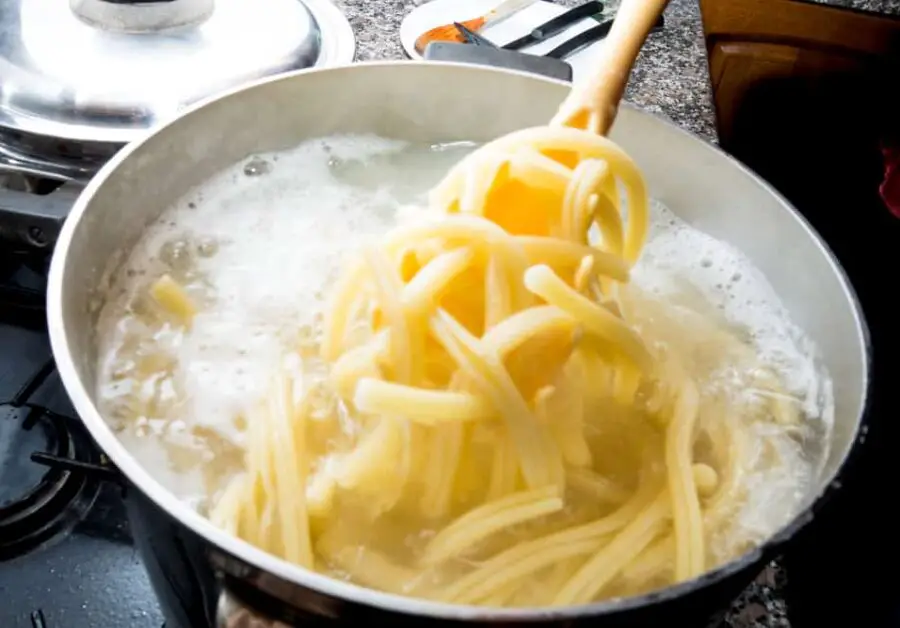Does this sound familiar?
You’ve planned a big pasta dinner and thrown it in a pot, turned on the burner and forgotten about it.
Ten minutes go by and the next thing you know, you’ve got an eruption of foamy white on your hands. The sticky residue it leaves behind is not only a headache but it can be a real pain to clean up.
While there are some things you can do to eliminate the problem, the question is why does pasta foam?
The somewhat technical/nerdy answer is that pasta is a type of food that contains surfactants – specifically fat and protein. A surfactant is a compound that reduces the tension of surfaces between liquid and a gas or with pasta, the surface tension between a liquid (the water in the pot) and a solid (the pasta you’re cooking). As the water temperature rises, the surfactants released by pasta lower the surface tension of the water and cause it to foam.
What Is the Foam in Pasta?
The fat and protein compounds in pasta include flour, water and possibly eggs.
When combined, this starchy mix is primed to absorb the water in the pot as it heats. At a certain point, this buildup will cause the release of the pasta’s surfactants resulting in the water’s foamy appearance.
The bubbles produced by pasta are pliable and capable of significant expansion before they burst. You can easily observe this flexibility by how rapidly the bubbles begin to rise once the water boils. Steam accumulates within the bubbles and causes a superheating effect which left unchecked will find a way over the sides of the pot.
As anyone who’s ever hurried across the kitchen to snatch a boiling pot from the stove, you know the foaming happens rapidly!
Can You Soak Pasta Instead of Boiling?
Yes, you can soak pasta instead of boiling it.
Whether you do or not will depend on the amount of time you have to make your meal. Pasta doesn’t need to be heated in order to use it in a recipe, it simply needs to be hydrated.
An easy way to do it is just portion out the pasta you need in water and leave it out at room temperature for a few hours or if you prefer, in the fridge overnight.
Whenever you’re ready to add it to your decadent lasagna or scrumptious pepperoni pasta bake, drain the bowl and remove the pasta. It can also be added to heated pasta sauce and eaten.
Should You Skim Off White Foam When Boiling Pasta?
Skimming white foam off the top of a boiling pot of pasta isn’t worthwhile. When pasta is boiled, the surfactants in the pasta will just continue to produce foam.
A better solution than skimming is to simply turn down the burner and reduce the temperature of the water instead or use a larger pot to cook the pasta.
Should Pasta Be Cooked Covered or Uncovered?
The answer is a little of both.
The best approach would be to cover the pot before adding the pasta while the water is reaching its boiling point. As it does, and you add the pasta and then cook it uncovered.
How to Stop Pasta Boiling Over in Microwave
Unfortunately, microwaving pasta doesn’t eliminate the problem of foaming.
The best approach is to keep an eye on it while it’s cooking and as foam accumulates, remove the dish and stir it to break the surface tension of the foam before returning it to the microwave and continue cooking.
Alternatively, you could try the wooden spoon trick which we’ll discuss next.
Why Does the Wooden Spoon Trick Work?
For as long as I can remember, using a wooden spoon was always a family secret that was used to keep a bubbling pot under control.
As I got older, I learned that this old wives’ tale has been around for ages, but is the idea that a wooden spoon will stop a pot from boiling over fact or fiction?
In this interesting experiment, it was demonstrated that yes, placing a wooden spoon over a boiling pot of water did help to prevent it from boiling over.
The question is why.
If you’ll recall from earlier in the article, pasta contains surfactants. When the water heats, the surfactants are released, causing a rapid expansion of bubbles and subsequently, the dreaded white foam.
Okay, now back to the spoon…
What they discovered was that the spoon performed two functions that helped keep the boiling water under control. The first function was to absorb heat coming from the pot while the secondary function was disrupting the surface tension of the bubbles that the pasta created, which prevented them from rising, bursting and spilling over.
So the next time you’re boiling some pasta, the wooden spoon trick might be worth a try!

Hiya! I’m Kimberly, a contributing writer here at Miss Buttercup. I was born and raised in the UP, Michigan’s Upper Peninsula for those who don’t know, the land of beautiful, beach-filled sunny summer days and bone-chilling long winters. Growing up there made me appreciate all the little things about life, especially the way a delicious meal can bring people closer together. I try and put that same feeling into each article I write and I hope it comes across that way!

